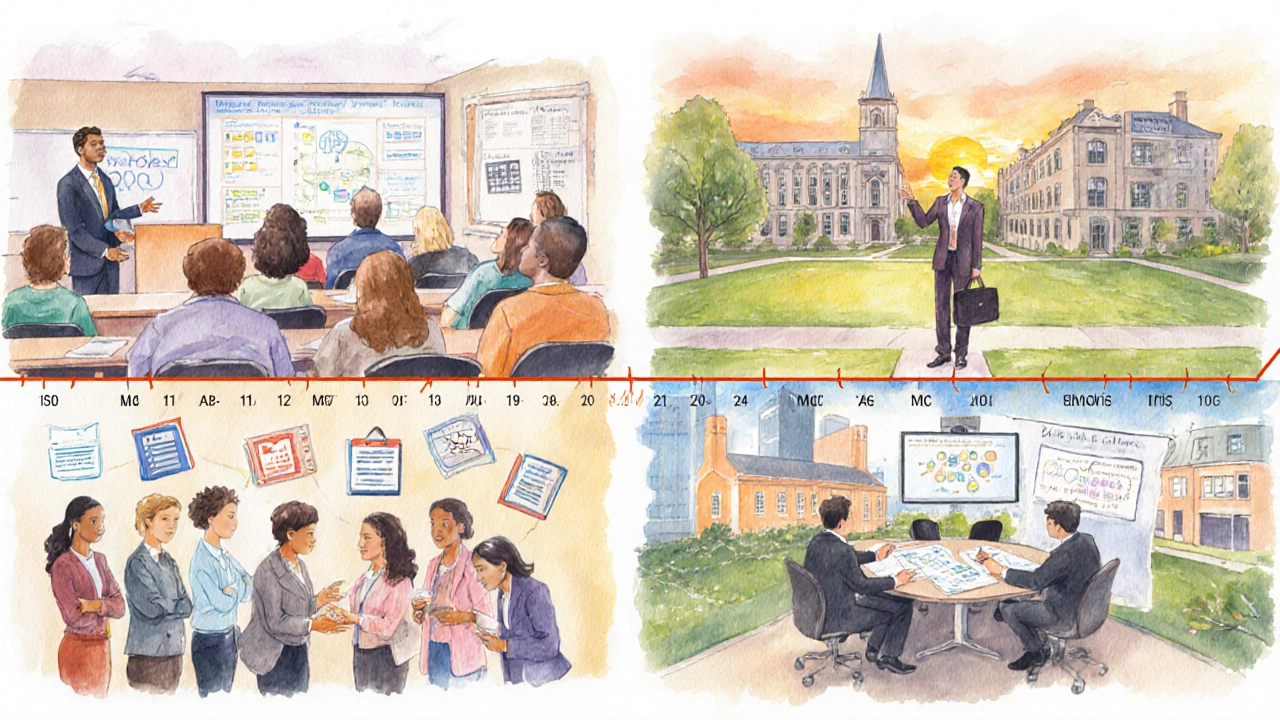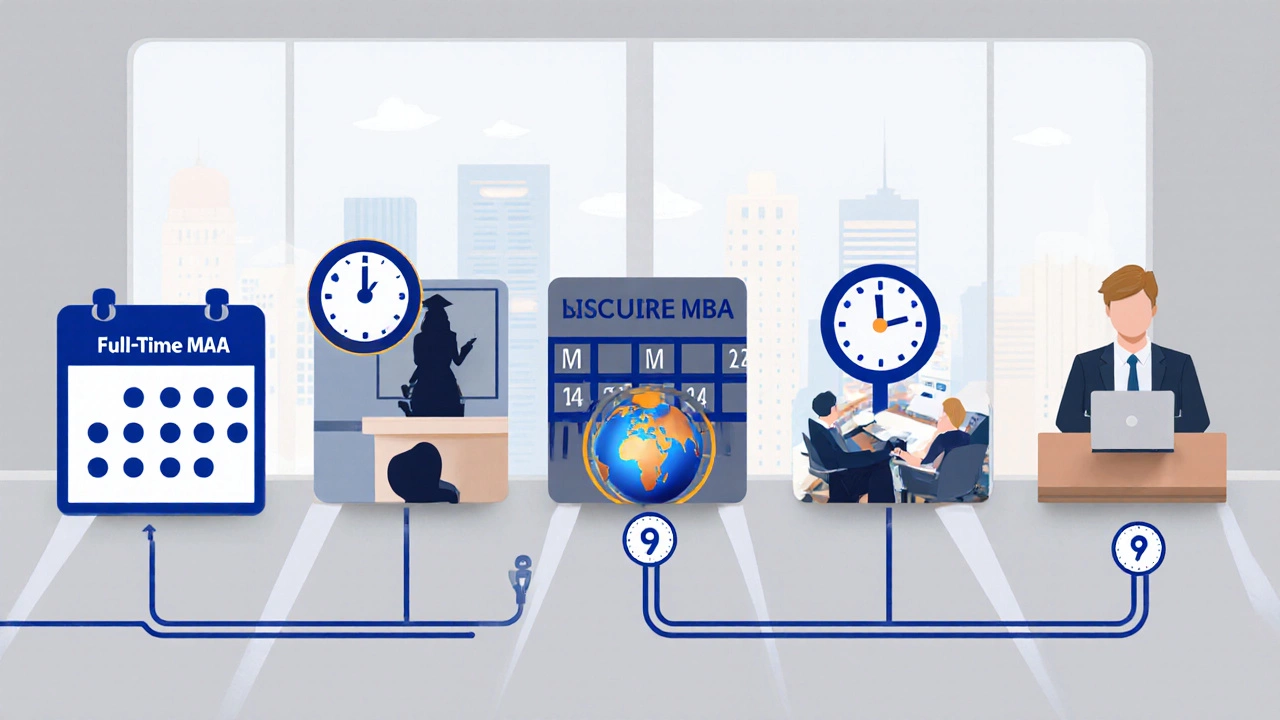MBA Duration Estimator
Find Your Ideal Program Duration
Select your circumstances to estimate the MBA program length that best fits your goals.
Your Estimated MBA Duration
12-24 months
Based on your selections, this duration range reflects typical program lengths. Actual time may vary by school and individual circumstances.
Wondering how long an MBA degree is - a graduate business qualification that prepares you for leadership roles? The answer isn’t one‑size‑fits‑all. Depending on the program type, your background, and the school’s format, the clock can tick anywhere from 12 months to five years. This guide breaks down every common pathway, so you can match the timeline to your career goals and life situation.
Quick Summary
- Full‑time MBA: 12‑24 months (most 2‑year programs)
- Part‑time MBA: 24‑48 months, often evenings/weekends
- Executive MBA (EMBA): 15‑24 months, designed for senior pros
- Online MBA: 12‑36 months, flexible pacing
- Accelerated options: 9‑12 months, intense and cost‑effective
Understanding the MBA Structure
Before hunting for the perfect Business school - the institution that offers the MBA curriculum, it helps to know what you’ll actually study. Most programs cover core subjects like finance, marketing, operations, strategy, and leadership. These are usually followed by electives that let you specialize (e.g., entrepreneurship, healthcare, tech management). The total credit load typically ranges from 60 to 90 semester units.
Many schools also require a capstone project or a consulting assignment that mimics real‑world decision‑making. Some add a summer internship, especially in two‑year full‑time tracks, to give you hands‑on experience before you graduate.
Program Types and Their Typical MBA duration
| Program | Typical Length | Study Mode | Ideal For |
|---|---|---|---|
| Full‑time MBA | 12-24 months | Day‑time classes, on‑campus | Career switchers, recent grads |
| Part‑time MBA | 24-48 months | Evenings/weekends, often on‑campus | Working professionals keeping a job |
| Executive MBA (EMBA) | 15-24 months | Monthly intensive modules, sometimes global residencies | Mid‑level managers aiming for senior leadership |
| Online MBA | 12-36 months | Fully virtual, self‑paced or cohort‑based | Those needing geographic flexibility |
| Accelerated MBA | 9-12 months | Intensive, often full‑time but condensed | Students who want to return to work quickly |

Full‑Time vs. Part‑Time vs. Executive vs. Online: What Influences Length?
GMAT - the Graduate Management Admission Test used by many schools for admission scores, prior work experience, and personal commitments all shape which format makes sense. Full‑time routes assume you can quit (or pause) your job, letting you finish faster. Part‑time and EMBA programs stretch out because they blend classes with ongoing employment.
Online programs add another variable: pacing. Some schools lock you into a cohort with deadlines, while others let you progress as soon as you master each module. This flexibility can either shorten or lengthen the overall timeline, depending on how disciplined you are.
Factors That Can Shorten or Extend Your MBA Journey
- Credit Transfer - If you already hold a bachelor’s degree with business electives, you might receive up to 15 waived credits, shaving months off.
- Summer Internship - Required in most two‑year programs; adds a real‑world stint but also delays graduation.
- Accelerated Tracks - Some schools bundle core courses into a single semester, demanding a heavier workload but cutting time.
- Professional Experience - Executive programs often waive certain core requirements for seasoned leaders, trimming length.
- Accreditation Standards - Institutions accredited by AACSB or EQUIS must meet minimum credit hours, which can set a floor on duration.
Typical Curriculum Timeline for a Two‑Year Full‑Time MBA
Here’s a month‑by‑month snapshot that many top schools follow:
- Months 1‑4: Core foundation - accounting, finance, statistics, and organizational behavior.
- Months 5‑8: Advanced electives - choose a concentration like digital marketing or supply chain.
- Month 9: Summer internship - 8‑12 weeks at a partner firm.
- Months 10‑12: Capstone project - a group consulting assignment for a real client.
Graduate in May, then you’re ready to job hunt or step into a new role.

Accelerated and Hybrid Options You Might Not Know
Some schools now blend formats: a 15‑month hybrid MBA that mixes on‑campus residencies with online modules. Others partner with industry giants to offer a dual‑degree where you earn an MBA and a niche certificate in the same timeframe. These hybrids aim to keep the learning curve steep while respecting busy schedules.
Choosing the Right Length for Your Career Goals
If you need a swift career switch, a 12‑month full‑time or accelerated MBA could be ideal - you’ll be back in the job market quickly, though you’ll have to sacrifice a regular salary for that year. If you’re already climbing the corporate ladder and can’t afford a break, a part‑time or EMBA lets you learn while you earn, even if it stretches to three or four years.
International students often pick a one‑year program to meet visa timelines, while professionals in regulated fields (like healthcare) may opt for a part‑time route that aligns with licensing requirements.
Frequently Asked Questions
What is the shortest possible MBA program?
Some elite schools run a 9‑month accelerated MBA that packs all core and elective courses into three intense semesters. You’ll need a strong academic record and be ready for a heavy workload.
Can I finish an MBA while working full‑time?
Yes. Part‑time and executive formats are built for that scenario. Expect the program to last 2‑4 years, with classes scheduled evenings, weekends, or in short monthly residencies.
Do online MBAs take longer than on‑campus ones?
Not necessarily. Some online MBAs are self‑paced and can be finished in 12 months, while others follow a cohort rhythm that may stretch to 24‑36 months. Your own speed determines the final timeline.
How does accreditation affect program length?
Accrediting bodies like AACSB set minimum credit requirements (usually 60-70). Schools can’t shave those hours below the threshold, so even the fastest programs must meet that baseline.
Is a summer internship mandatory for every MBA?
It’s common in two‑year full‑time tracks but not required for part‑time, EMBA, or many online programs. Some schools replace it with a consulting project.

